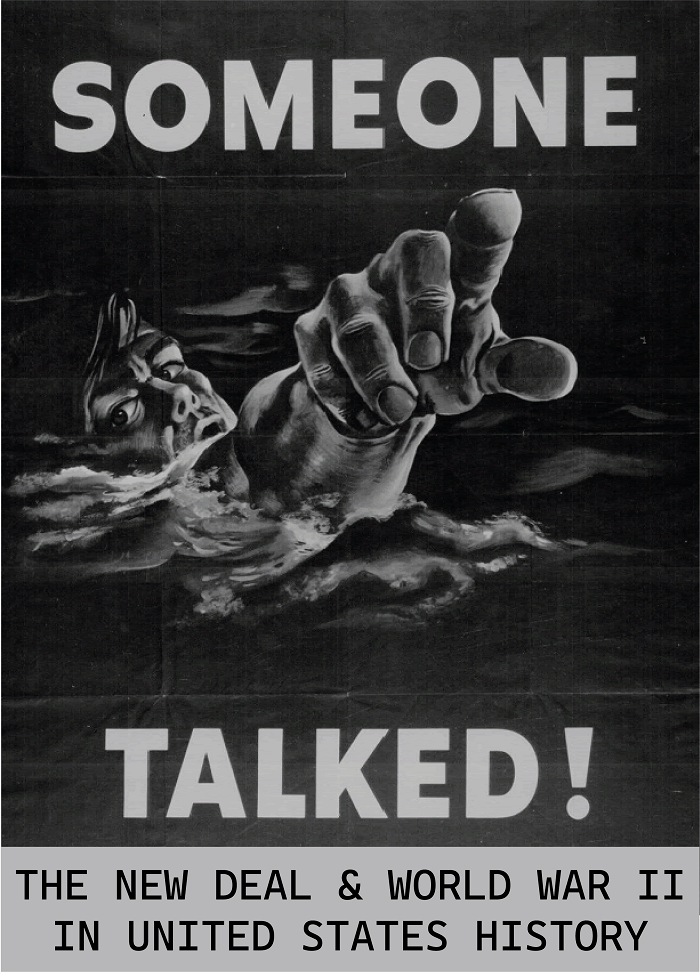The period of United States history that included the New Deal and World War II was marked by a series of transformative events and government interventions.
 The New Deal (1930s): The New Deal was a comprehensive set of programs and policies initiated by President Franklin D. Roosevelt in response to the Great Depression, which had plunged the nation into economic turmoil. Roosevelt's New Deal aimed to provide relief to those suffering from the economic crisis, stimulate economic recovery, and implement long-term reforms to prevent future economic downturns. Key components included Social Security, the Civilian Conservation Corps (CCC), the Works Progress Administration (WPA), and the Tennessee Valley Authority (TVA). The New Deal reshaped the role of the federal government in the economy and established a social safety net for American citizens.
The New Deal (1930s): The New Deal was a comprehensive set of programs and policies initiated by President Franklin D. Roosevelt in response to the Great Depression, which had plunged the nation into economic turmoil. Roosevelt's New Deal aimed to provide relief to those suffering from the economic crisis, stimulate economic recovery, and implement long-term reforms to prevent future economic downturns. Key components included Social Security, the Civilian Conservation Corps (CCC), the Works Progress Administration (WPA), and the Tennessee Valley Authority (TVA). The New Deal reshaped the role of the federal government in the economy and established a social safety net for American citizens.
World War II (1939-1945): World War II was a global conflict that the United States entered in 1941 after the attack on Pearl Harbor. It was a critical period during which the nation mobilized its resources, both human and industrial, to support the war effort. The war had a profound impact on American society and the economy. The U.S. became the "Arsenal of Democracy," producing vast quantities of weapons, equipment, and supplies for the Allied forces. The war also led to significant social changes, including the increased participation of women in the workforce and the military (Rosie the Riveter), as well as the internment of Japanese Americans. The war ended with the dropping of atomic bombs on Hiroshima and Nagasaki in 1945, leading to Japan's surrender.
This period witnessed the United States transitioning from the depths of the Great Depression to a period of economic and industrial expansion driven by the demands of World War II. The New Deal provided a foundation for government intervention in the economy, and the experience of World War II solidified the nation's position as a global superpower. These events left a lasting impact on the United States, shaping its economic policies, social structures, and global role in the post-war era.
|
 The New Deal (1930s): The New Deal was a comprehensive set of programs and policies initiated by President Franklin D. Roosevelt in response to the Great Depression, which had plunged the nation into economic turmoil. Roosevelt's New Deal aimed to provide relief to those suffering from the economic crisis, stimulate economic recovery, and implement long-term reforms to prevent future economic downturns. Key components included Social Security, the Civilian Conservation Corps (CCC), the Works Progress Administration (WPA), and the Tennessee Valley Authority (TVA). The New Deal reshaped the role of the federal government in the economy and established a social safety net for American citizens.
The New Deal (1930s): The New Deal was a comprehensive set of programs and policies initiated by President Franklin D. Roosevelt in response to the Great Depression, which had plunged the nation into economic turmoil. Roosevelt's New Deal aimed to provide relief to those suffering from the economic crisis, stimulate economic recovery, and implement long-term reforms to prevent future economic downturns. Key components included Social Security, the Civilian Conservation Corps (CCC), the Works Progress Administration (WPA), and the Tennessee Valley Authority (TVA). The New Deal reshaped the role of the federal government in the economy and established a social safety net for American citizens. 






